The Nonlinear and Threshold Effect of Built Environment on Ride-Hailing Travel Demand
Abstract
:1. Introduction
2. Literature Review
2.1. Impact of the Built Environment on Ride-Hailing
2.2. Nonlinear Effects between Traffic Travel and Influencing Factors
3. Data
3.1. Study Area
3.2. Variables
4. Methodology
4.1. XGBoost
4.2. Model Explanation
5. Results and Discussion
5.1. Relative Importance Analysis
5.2. SHAP Summary Plot of Independent Variables
5.3. Marginal Effects Analysis
6. Conclusions
Author Contributions
Funding
Institutional Review Board Statement
Informed Consent Statement
Data Availability Statement
Acknowledgments
Conflicts of Interest
References
- Rayle, L.; Dai, D.; Chan, N.; Cervero, R.; Shaheen, S. Just a better taxi? A survey-based comparison of taxis, transit, and ridesourcing services in San Francisco. Transp. Policy 2016, 45, 168–178. [Google Scholar] [CrossRef]
- Young, M.; Allen, J.; Farber, S. Measuring when Uber behaves as a substitute or supplement to transit: An examination of travel-time differences in Toronto. J. Transp. Geogr. 2020, 82, 102629. [Google Scholar] [CrossRef]
- Zhang, B.; Chen, S.; Ma, Y.; Li, T.; Tang, K. Analysis on spatiotemporal urban mobility based on online car-hailing data. J. Transp. Geogr. 2020, 82, 102568. [Google Scholar] [CrossRef]
- Shi, K.; Shao, R.; De Vos, J.; Cheng, L.; Witlox, F. The influence of ride-hailing on travel frequency and mode choice. Transp. Res. Part D Transp. Environ. 2021, 101, 103125. [Google Scholar] [CrossRef]
- Yin, C.; Lu, Y.; Shao, C.; Ma, J.; Xu, D. Impacts of built environment on commuting mode choice considering spatial autocorrelation. J. Jilin Univ. (Eng. Technol. Ed.) 2023, 53, 1994–2000. [Google Scholar] [CrossRef]
- Wang, X.; Shao, C.; Yin, C.; Guan, L. Exploring the relationships of the residential and workplace built environment with commuting mode choice: A hierarchical cross-classified structural equation model. Transp. Lett. 2022, 14, 274–281. [Google Scholar] [CrossRef]
- Yin, C.; Wang, X.; Shao, C.; Ma, J. Exploring the Relationship between Built Environment and Commuting Mode Choice: Longitudinal Evidence from China. Int. J. Environ. Res. Public Health 2022, 19, 14149. [Google Scholar] [CrossRef] [PubMed]
- Du, Q.; Zhou, Y.; Huang, Y.; Wang, Y.; Bai, L. Spatiotemporal exploration of the non-linear impacts of accessibility on metro ridership. J. Transp. Geogr. 2022, 102, 103380. [Google Scholar] [CrossRef]
- Peng, B.; Zhang, Y.; Li, C.; Wang, T.; Yuan, S. Nonlinear, threshold and synergistic effects of first/last-mile facilities on metro ridership. Transp. Res. Part D Transp. Environ. 2023, 121, 103856. [Google Scholar] [CrossRef]
- Chen, C.; Feng, T.; Ding, C.; Yu, B.; Yao, B. Examining the spatial-temporal relationship between urban built environment and taxi ridership: Results of a semi-parametric GWPR model. J. Transp. Geogr. 2021, 96, 103172. [Google Scholar] [CrossRef]
- Qian, X.; Ukkusuri, S.V. Spatial variation of the urban taxi ridership using GPS data. Appl. Geogr. 2015, 59, 31–42. [Google Scholar] [CrossRef]
- Zhu, P.; Li, J.; Wang, K.; Huang, J. Exploring spatial heterogeneity in the impact of built environment on taxi ridership using multiscale geographically weighted regression. Transportation 2023. [Google Scholar] [CrossRef]
- Ma, X.; Ji, Y.; Yuan, Y.; Van Oort, N.; Jin, Y.; Hoogendoorn, S. A comparison in travel patterns and determinants of user demand between docked and dockless bike-sharing systems using multi-sourced data. Transp. Res. Part A Policy Pract. 2020, 139, 148–173. [Google Scholar] [CrossRef]
- Wang, Y.; Li, J.; Su, D.; Zhou, H. Spatial-temporal heterogeneity and built environment nonlinearity in inconsiderate parking of dockless bike-sharing. Transp. Res. Part A: Policy Pract. 2023, 175, 103789. [Google Scholar] [CrossRef]
- Wang, X.; Shao, C.; Yin, C.; Dong, C. Exploring the effects of the built environment on commuting mode choice in neighborhoods near public transit stations: Evidence from China. Transp. Plan. Technol. 2021, 44, 111–127. [Google Scholar] [CrossRef]
- Wang, X.; Shao, C.; Yin, C.; Zhuge, C. Exploring the Influence of Built Environment on Car Ownership and Use with a Spatial Multilevel Model: A Case Study of Changchun, China. Int. J. Environ. Res. Public Health 2018, 15, 1868. [Google Scholar] [CrossRef] [PubMed]
- Yin, C.; Shao, C.; Wang, X. Exploring the impact of built environment on car use: Does living near urban rail transit matter? Transp. Lett. 2020, 12, 391–398. [Google Scholar] [CrossRef]
- Dean, M.D.; Kockelman, K.M. Spatial variation in shared ride-hail trip demand and factors contributing to sharing: Lessons from Chicago. J. Transp. Geogr. 2021, 91, 102944. [Google Scholar] [CrossRef]
- Fotheringham, A.S.; Charlton, M.E.; Brunsdon, C. Geographically Weighted Regression: A Natural Evolution of the Expansion Method for Spatial Data Analysis. Environ. Plan. A 1998, 30, 1905–1927. [Google Scholar] [CrossRef]
- Liu, F.; Gao, F.; Yang, L.; Han, C.; Hao, W.; Tang, J. Exploring the spatially heterogeneous effect of the built environment on ride-hailing travel demand: A geographically weighted quantile regression model. Travel Behav. Soc. 2022, 29, 22–33. [Google Scholar] [CrossRef]
- Wang, S.; Noland, R.B. Variation in ride-hailing trips in Chengdu, China. Transp. Res. Part D Transp. Environ. 2021, 90, 102596. [Google Scholar] [CrossRef]
- Yu, H.; Peng, Z.-R. Exploring the spatial variation of ridesourcing demand and its relationship to built environment and socioeconomic factors with the geographically weighted Poisson regression. J. Transp. Geogr. 2019, 75, 147–163. [Google Scholar] [CrossRef]
- Ji, S.; Wang, X.; Lyu, T.; Liu, X.; Wang, Y.; Heinen, E.; Sun, Z. Understanding cycling distance according to the prediction of the XGBoost and the interpretation of SHAP: A non-linear and interaction effect analysis. J. Transp. Geogr. 2022, 103, 103414. [Google Scholar] [CrossRef]
- Tao, T.; Cao, J. Exploring nonlinear and collective influences of regional and local built environment characteristics on travel distances by mode. J. Transp. Geogr. 2023, 109, 103599. [Google Scholar] [CrossRef]
- Tu, M.; Li, W.; Orfila, O.; Li, Y.; Gruyer, D. Exploring nonlinear effects of the built environment on ridesplitting: Evidence from Chengdu. Transp. Res. Part D Transp. Environ. 2021, 93, 102776. [Google Scholar] [CrossRef]
- Ghaffar, A.; Mitra, S.; Hyland, M. Modeling determinants of ridesourcing usage: A census tract-level analysis of Chicago. Transp. Res. Part C Emerg. Technol. 2020, 119, 102769. [Google Scholar] [CrossRef]
- Gomez, J.; Aguilera-García, Á.; Dias, F.F.; Bhat, C.R.; Vassallo, J.M. Adoption and frequency of use of ride-hailing services in a European city: The case of Madrid. Transp. Res. Part C Emerg. Technol. 2021, 131, 103359. [Google Scholar] [CrossRef]
- Dong, X. Trade Uber for the Bus? An Investigation of Individual Willingness to Use Ride-Hail Versus Transit. J. Am. Plan. Assoc. 2020, 86, 222–235. [Google Scholar] [CrossRef]
- Loa, P.; Habib, K.N. Examining the influence of attitudinal factors on the use of ride-hailing services in Toronto. Transp. Res. Part A Policy Pract. 2021, 146, 13–28. [Google Scholar] [CrossRef]
- Ewing, R.; Cervero, R. Travel and the Built Environment: A meta-analysis. J. Am. Plan. Assoc. 2010, 76, 265–294. [Google Scholar] [CrossRef]
- Ewing, R.; Cervero, R. Travel and the Built Environment: A Synthesis. Transp. Res. Rec. J. Transp. Res. Board 2001, 1780, 87–114. [Google Scholar] [CrossRef]
- Alemi, F.; Circella, G.; Handy, S.; Mokhtarian, P. What influences travelers to use Uber? Exploring the factors affecting the adoption of on-demand ride services in California. Travel Behav. Soc. 2018, 13, 88–104. [Google Scholar] [CrossRef]
- Sabouri, S.; Park, K.; Smith, A.; Tian, G.; Ewing, R. Exploring the influence of built environment on Uber demand. Transp. Res. Part D Transp. Environ. 2020, 81, 102296. [Google Scholar] [CrossRef]
- Wang, X.; Yin, C.; Zhang, J.; Shao, C.; Wang, S. Nonlinear effects of residential and workplace built environment on car dependence. J. Transp. Geogr. 2021, 96, 103207. [Google Scholar] [CrossRef]
- He, M.; Pu, L.; Liu, Y.; Shi, Z.; He, C.; Lei, J. Research on Nonlinear Associations and Interactions for Short-Distance Travel Mode Choice of Car Users. J. Adv. Transp. 2022, 2022, 8598320. [Google Scholar] [CrossRef]
- Jin, T.; Cheng, L.; Zhang, X.; Cao, J.; Qian, X.; Witlox, F. Nonlinear effects of the built environment on metro-integrated ridesourcing usage. Transp. Res. Part D Transp. Environ. 2022, 110, 103426. [Google Scholar] [CrossRef]
- Statistical Communiqué on National Economic and Social Development of Nanjing in 2022. Available online: https://tjj.nanjing.gov.cn/bmfw/njsj/202303/t20230324_3871176.html (accessed on 12 October 2023).
- He, Z. Portraying ride-hailing mobility using multi-day trip order data: A case study of Beijing, China. Transp. Res. Part A Policy Pract. 2021, 146, 152–169. [Google Scholar] [CrossRef]
- Li, X.; Xu, J.; Du, M.; Liu, D.; Kwan, M.-P. Understanding the spatiotemporal variation of ride-hailing orders under different travel distances. Travel Behav. Soc. 2023, 32, 100581. [Google Scholar] [CrossRef]
- Zhao, F.; Ma, J.; Yin, C.; Tang, W.; Wang, X.; Yin, J. Spatiotemporal Heterogeneous Effects of Built Environment and Taxi Demand on Ride-Hailing Ridership. Appl. Sci. 2024, 14, 142. [Google Scholar] [CrossRef]
- Chen, T.; Guestrin, C.; Assoc Comp, M. XGBoost: A Scalable Tree Boosting System. In Proceedings of the 22nd ACM SIGKDD International Conference on Knowledge Discovery and Data Mining (KDD), San Francisco, CA, USA, 13–17 August 2016; pp. 785–794. [Google Scholar] [CrossRef]
- Shapley, L.S. A Value for N-Person Games; RAND Corporation: Santa Monica, CA, USA, 1952. [Google Scholar] [CrossRef]
- Lundberg, S.; Lee, S.-I. A Unified Approach to Interpreting Model Predictions. In Proceedings of the 31st International Conference on Neural Information Processing Systems (NIPS’17), Long Beach, CA, USA, 4–9 December 2017; Volume 30, p. 07874. [Google Scholar]
- Štrumbelj, E.; Kononenko, I. Explaining prediction models and individual predictions with feature contributions. Knowl. Inf. Systs. 2014, 41, 647–665. [Google Scholar] [CrossRef]
- Li, Z. Extracting spatial effects from machine learning model using local interpretation method: An example of SHAP and XGBoost. Comput. Environ. Urban Syst. 2022, 96, 101845. [Google Scholar] [CrossRef]
- Lyu, T.; Wang, Y.; Ji, S.; Feng, T.; Wu, Z. A multiscale spatial analysis of taxi ridership. J. Transp. Geogr. 2023, 113, 103718. [Google Scholar] [CrossRef]
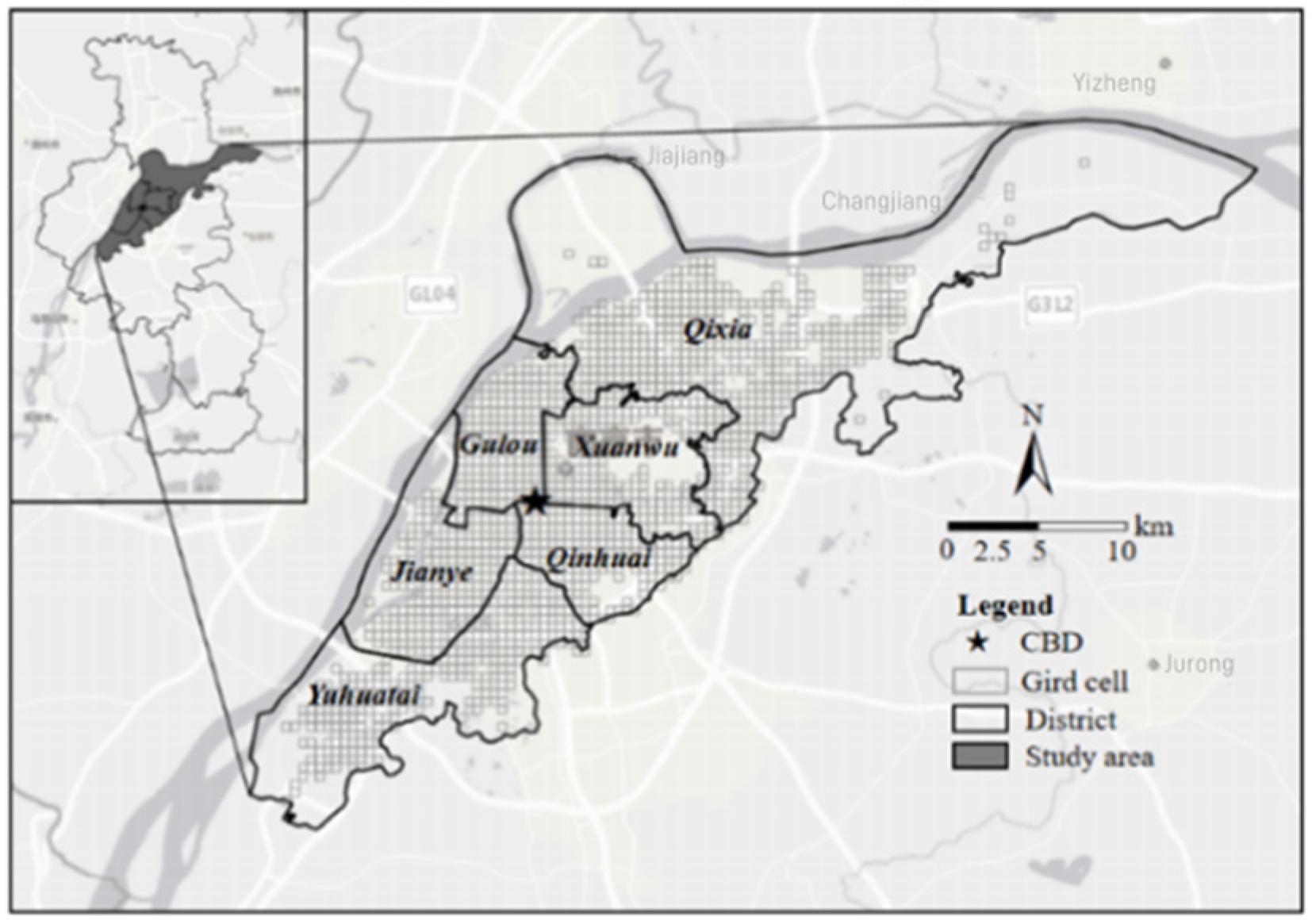

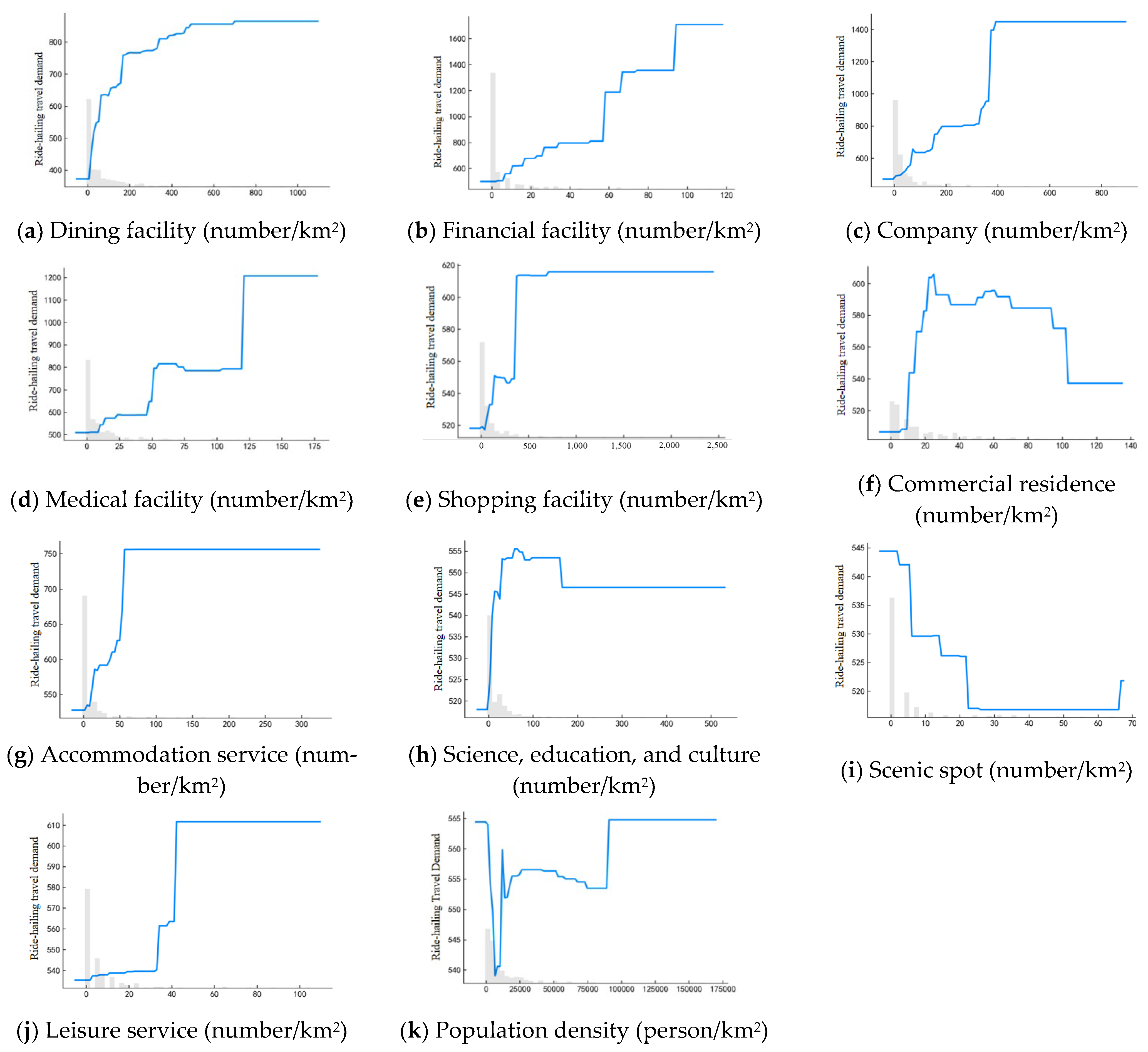

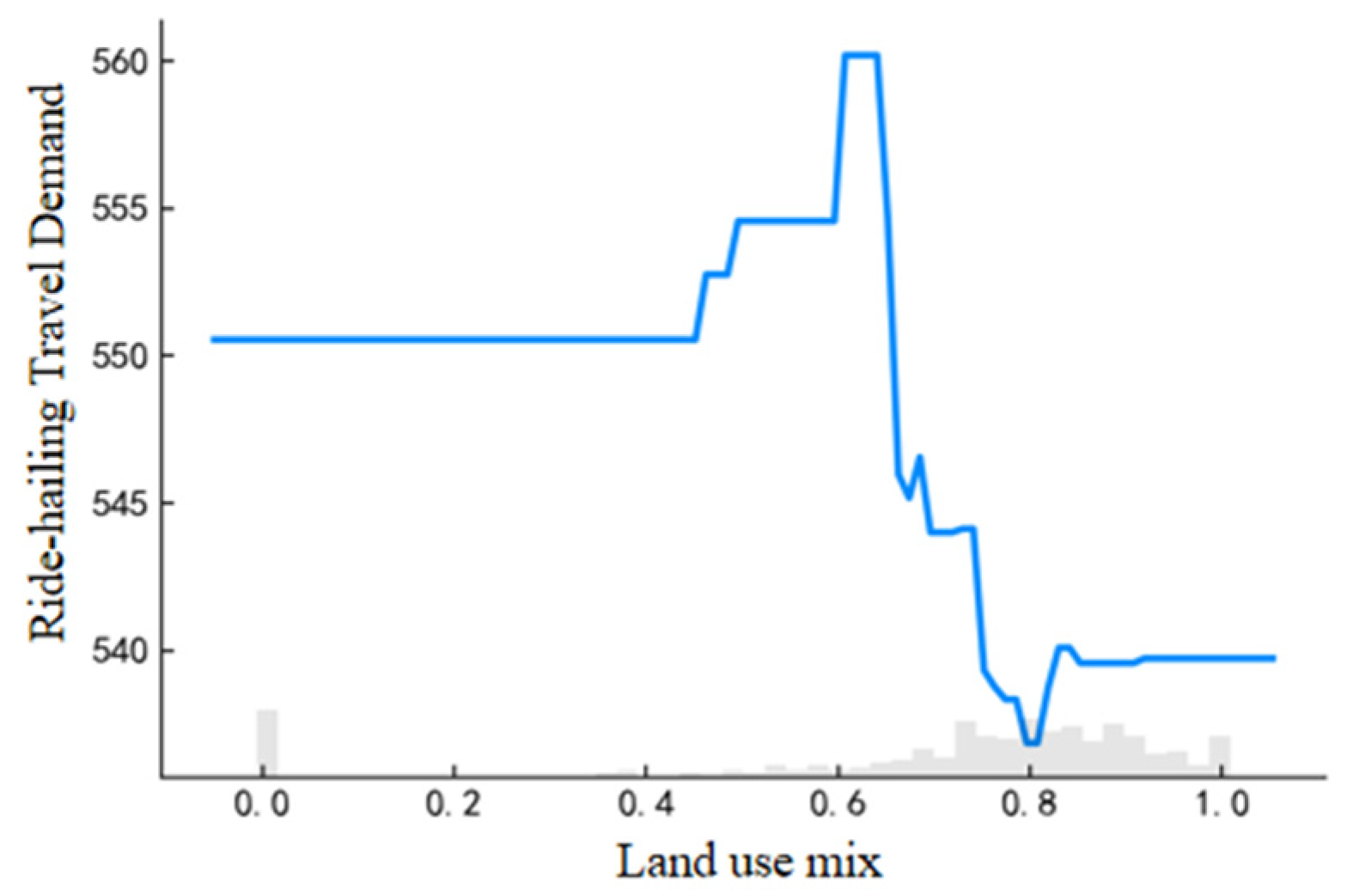
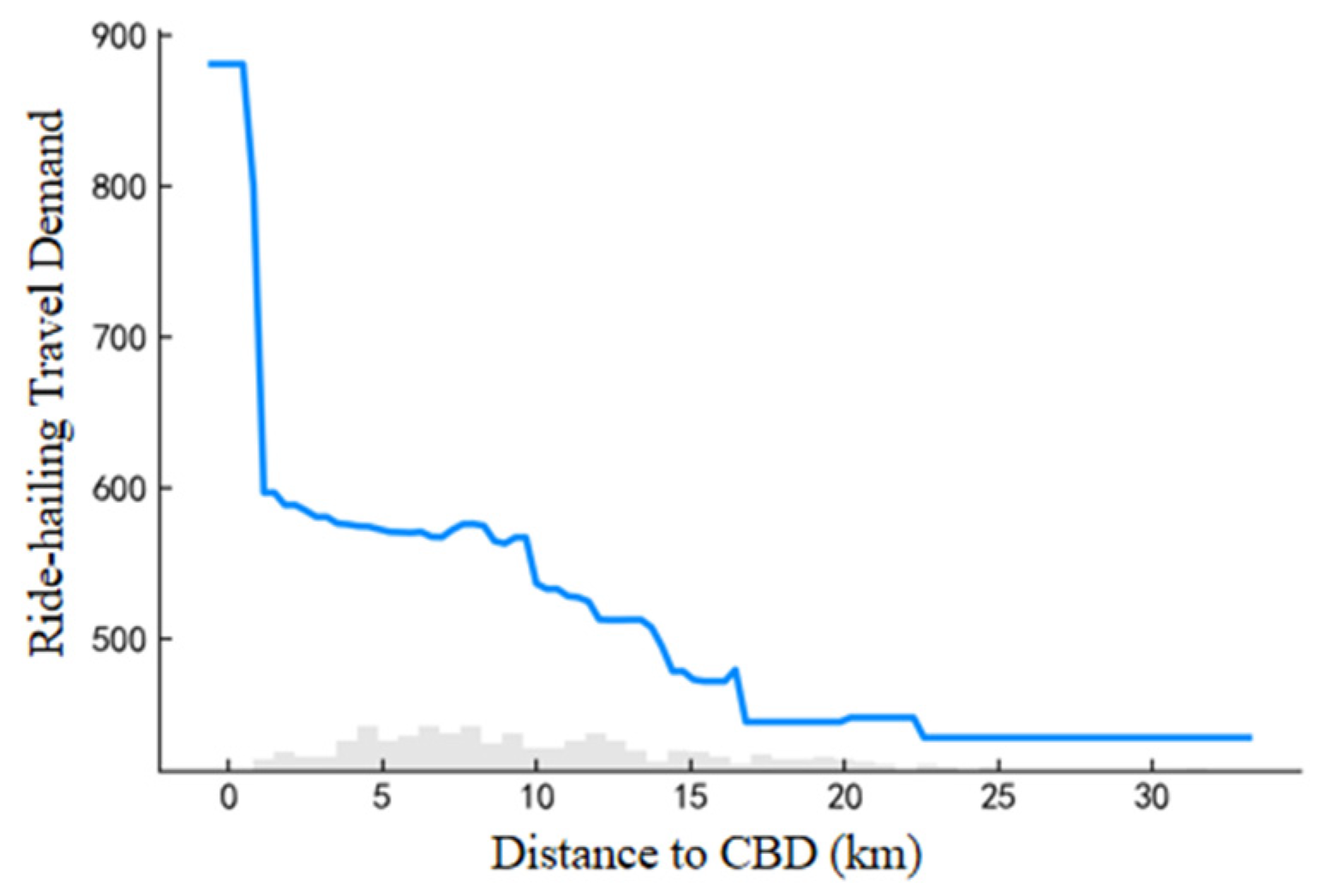
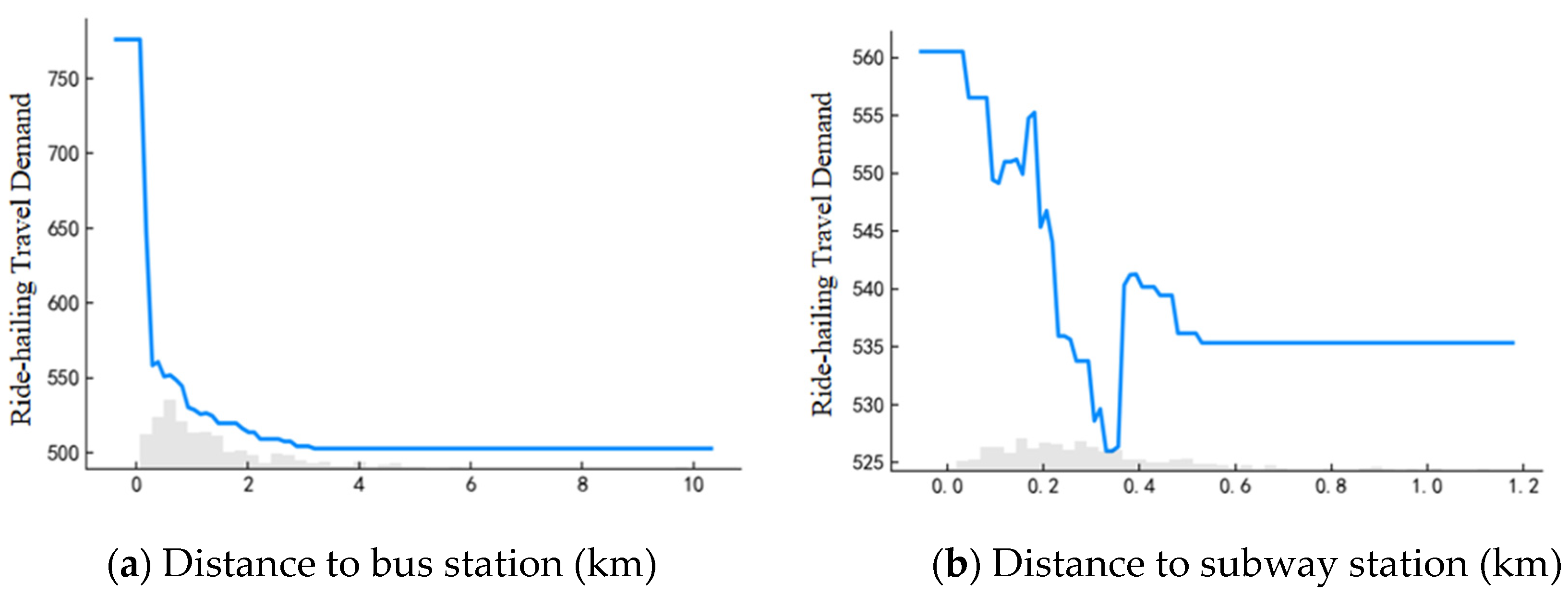
| Order ID | Vehicle ID | Pick-Up Time | Drop-Off Time | Pick-Up Location (LON, LAT) | Drop-Off Location (LON, LAT) |
|---|---|---|---|---|---|
| TS120220411012600XXX | SADXXX87 | 2022/4/11 01:33:59 | 2022/4/11 01:50:56 | (118.746650, 32.021847) | (118.787378, 32.048361) |
| 15fb8a0ea4422477fXXX | SA1XXXY | 2022/4/12 09:59:20 | 2022/4/12 10:21:39 | (118.823082, 31.964883) | (118.637144, 31.930987) |
| TS120220413155000XXX | SADXXX19 | 2022/4/13 15:54:21 | 2022/4/13 16:20:28 | (118.787103, 32.069792) | (118.734399, 32.127606) |
| TS120220414151003XXX | SADXXX53 | 2022/4/14 15:14:28 | 2022/4/14 15:33:21 | (118.816308, 32.066452) | (118.763203, 32.009617) |
| 17753565138XXX | SA8XXXC | 2022/4/15 12:34:17 | 2022/4/15 12:44:36 | (118.779821, 32.029380) | (118.787625, 32.043140) |
| Variable | Description | Mean | S.D. | Source |
|---|---|---|---|---|
| Dependent variables | ||||
| Ride-hailing travel demand | Number of ride-hailing trips divided by the grid area (count/km2) | 536.22 | 712.48 | Nanjing Transport |
| Independent variables | ||||
| Density | ||||
| Population density | Population size divided by the grid area (person/km2) | 12,641.95 | 19,460.06 | WorldPop |
| Dining facility | Number of dining facilities divided by the grid area (count/km2) | 69.09 | 130.90 | Chinese Amap |
| Company | Number of companies divided by the grid area (count/km2) | 37.79 | 67.99 | Chinese Amap |
| Shopping facility | Number of shopping facilities divided by the grid area (count/km2) | 99.77 | 228.37 | Chinese Amap |
| Financial facility | Number of financial facilities divided by the grid area (count/km2) | 6.41 | 16.57 | Chinese Amap |
| Accommodation service | Number of accommodation services divided by the grid area (count/km2) | 11.26 | 32.99 | Chinese Amap |
| Science, education, and culture | Number of science, education, and culture facilities divided by the grid area (count/km2) | 22.99 | 44.82 | Chinese Amap |
| Scenic spot | Number of scenic spots divided by the grid area (count/km2) | 5.23 | 18.76 | Chinese Amap |
| Commercial residence | Number of commercial residences divided by the grid area (count/km2) | 17.79 | 24.02 | Chinese Amap |
| Leisure service | Number of leisure services divided by the grid area (count/km2) | 5.32 | 12.40 | Chinese Amap |
| Medical facility | Number of medical facilities divided by the grid area (count/km2) | 12.87 | 23.21 | Chinese Amap |
| Design | ||||
| Road length | The length of roads divided by the grid area (km/km2) | 1.97 | 1.15 | OpenStreetMap |
| Non-motorized road length | The length of non-motorized roads divided by the grid area (km/km2) | 0.21 | 0.51 | OpenStreetMap |
| Number of road nodes | Number of road nodes divided by the grid area (count/km2) | 7.07 | 9.31 | OpenStreetMap |
| Diversity | ||||
| Land use mix | The entropy value of thirteen categories of POI | 0.71 | 0.28 | Chinese Amap |
| Destination accessibility | ||||
| Distance to CBD | Distance from the grid centroid to CBD (km) | 10.16 | 5.73 | Chinese Amap |
| Distance to transit | ||||
| Distance to bus stop | Distance from the grid centroid to the nearest bus stop (km) | 0.31 | 0.21 | Chinese Amap |
| Variables | Relative Importance | Ranking |
|---|---|---|
| Density (average of relative importance: 7.89%) | ||
| Population density | 1.36% | 15 |
| Dining facility | 30.75% | 1 |
| Company | 5.94% | 4 |
| Shopping facility | 4.86% | 5 |
| Financial facility | 26.42% | 2 |
| Accommodation service | 3.19% | 7 |
| Science, education, and culture | 1.34% | 16 |
| Scenic spot | 0.59% | 18 |
| Commercial residence | 3.56% | 6 |
| Leisure service | 2.55% | 9 |
| Medical facility | 6.28% | 3 |
| Design (average of relative importance: 1.86%) | ||
| Road length | 2.07% | 10 |
| Non-motorized road length | 1.88% | 11 |
| Number of road nodes | 1.63% | 13 |
| Diversity (average of relative importance: 1.48%) | ||
| Land use mix | 1.48% | 14 |
| Destination accessibility (sum of relative importance: 3.05%) | ||
| Distance to CBD | 3.05% | 8 |
| Distance to transit (average of relative importance: 1.53%) | ||
| Distance to bus stop | 1.23% | 17 |
| Distance to subway station | 1.82% | 12 |
Disclaimer/Publisher’s Note: The statements, opinions and data contained in all publications are solely those of the individual author(s) and contributor(s) and not of MDPI and/or the editor(s). MDPI and/or the editor(s) disclaim responsibility for any injury to people or property resulting from any ideas, methods, instructions or products referred to in the content. |
© 2024 by the authors. Licensee MDPI, Basel, Switzerland. This article is an open access article distributed under the terms and conditions of the Creative Commons Attribution (CC BY) license (https://creativecommons.org/licenses/by/4.0/).
Share and Cite
Yin, J.; Zhao, F.; Tang, W.; Ma, J. The Nonlinear and Threshold Effect of Built Environment on Ride-Hailing Travel Demand. Appl. Sci. 2024, 14, 4072. https://doi.org/10.3390/app14104072
Yin J, Zhao F, Tang W, Ma J. The Nonlinear and Threshold Effect of Built Environment on Ride-Hailing Travel Demand. Applied Sciences. 2024; 14(10):4072. https://doi.org/10.3390/app14104072
Chicago/Turabian StyleYin, Jiexiang, Feiyan Zhao, Wenyun Tang, and Jianxiao Ma. 2024. "The Nonlinear and Threshold Effect of Built Environment on Ride-Hailing Travel Demand" Applied Sciences 14, no. 10: 4072. https://doi.org/10.3390/app14104072






